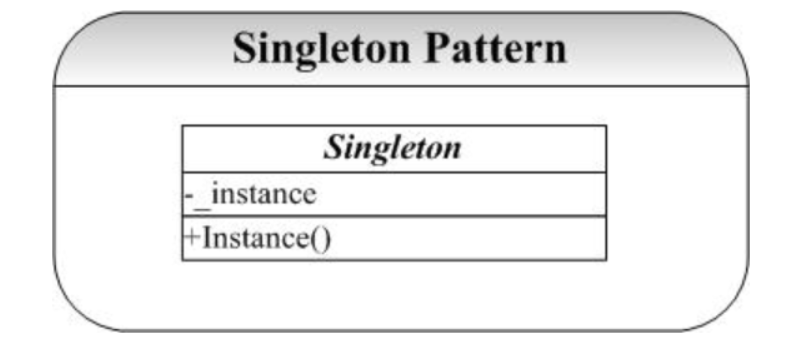创建型 - 单例模式(Singleton pattern)
单例模式(Singleton): 保证一个类仅有一个实例,并提供一个访问它的全局控制点. 比如在加载配置文件时, 可使用该模式。
概念
Singleton 模式典型的结构图为:

最基础的实现
注意单例模式从概念上就是维持一个唯一的实例对象,但是该对象不能直接创建,只能通过静态方法getInstance实现。同时,构造函数要声明为protected 或 private,避免被显示调用。
代码实现
#ifndef _SINGLETON_H_
#define _SINGLETON_H_
#include <iostream>
using namespace std;
class Singleton
{
public:
static Singleton* getInstance();
//~Singleton();
protected:
Singleton();//Singleton 不能被实例化,因此将构造函数声明为protected 或 private
private:
static Singleton* _instance;
};
#endif //~_SINGLETON_H_1
2
3
4
5
6
7
8
9
10
11
12
13
14
15
16
17
18
2
3
4
5
6
7
8
9
10
11
12
13
14
15
16
17
18
#include "Singleton.h"
#include <iostream>
Singleton* Singleton::_instance = 0;
Singleton::Singleton()
{
cout<<"Singleton()"<<endl;
}
/* Singleton::~Singleton()
{
cout<<"~Singleton()"<<endl;
} */
Singleton* Singleton::getInstance()
{
if (_instance == 0)
{
_instance = new Singleton();
}
return _instance;
}1
2
3
4
5
6
7
8
9
10
11
12
13
14
15
16
17
18
19
20
21
22
23
2
3
4
5
6
7
8
9
10
11
12
13
14
15
16
17
18
19
20
21
22
23
#include "Singleton.h"
#include <iostream>
using namespace std;
int main()
{
Singleton* sgn = Singleton::getInstance();
return 0;
}1
2
3
4
5
6
7
8
9
10
2
3
4
5
6
7
8
9
10
[root@VM-16-6-centos base_use]# ./Singleton
Singleton()
1
2
2
线程安全
考虑到线程安全和内存泄漏,进一步改进:
单例模式对象是禁止拷贝构造和赋值的
利用智能指针shared_ptr来自动释放申请的内存
为了避免多个线程同时调用getInstance函数引起错误,加入互斥锁,确保仅创建一个实例。
代码实现
#ifndef _SINGLETON_H_
#define _SINGLETON_H_
#include <iostream>
#include <memory>
#include <mutex>
using namespace std;
class Singleton{
public:
typedef std::shared_ptr<Singleton> Ptr;
Singleton(Singleton&)=delete;//禁止拷贝构造
Singleton& operator=(const Singleton&)=delete;//禁止赋值
static Ptr getInstance();
~Singleton();
private:
Singleton();
private:
static Ptr m_instance_ptr;
static std::mutex m_mutex;
};
#endif //~_SINGLETON_H_1
2
3
4
5
6
7
8
9
10
11
12
13
14
15
16
17
18
19
20
21
22
23
24
25
26
27
2
3
4
5
6
7
8
9
10
11
12
13
14
15
16
17
18
19
20
21
22
23
24
25
26
27
#include "Singleton.h"
Singleton::Ptr Singleton::m_instance_ptr = nullptr;
std::mutex Singleton::m_mutex;//静态变量不写默认为NULL
Singleton::Singleton()
{
cout<<"Singleton()"<<endl;
}
Singleton::~Singleton()
{
cout<<"~Singleton()"<<endl;
}
Singleton::Ptr Singleton::getInstance()
{
if(m_instance_ptr==nullptr)
{
std::lock_guard<std::mutex> lk(m_mutex);
if(m_instance_ptr == nullptr)
{
m_instance_ptr = std::shared_ptr<Singleton>(new Singleton);
}
}
return m_instance_ptr;
}
1
2
3
4
5
6
7
8
9
10
11
12
13
14
15
16
17
18
19
20
21
22
23
24
25
26
27
28
2
3
4
5
6
7
8
9
10
11
12
13
14
15
16
17
18
19
20
21
22
23
24
25
26
27
28
#include "Singleton.h"
#include <iostream>
using namespace std;
int main()
{
Singleton::Ptr m_singleton = Singleton::getInstance();
return 0;
}1
2
3
4
5
6
7
8
9
10
2
3
4
5
6
7
8
9
10
[root@VM-16-6-centos safe_use]# ./Singleton
Singleton()
~Singleton()
1
2
3
2
3
智能指针封装
考虑封装单例智能指针类,通过typedef SingletonPtr
代码实现
#ifndef _SINGLETONPTR_H_
#define _SINGLETONPTR_H_
#include <iostream>
#include <memory>
using namespace std;
/**
* @brief 单例模式智能指针封装类
* @details T 类型
* X 为了创造多个实例对应的Tag
* N 同一个Tag创造多个实例索引
*/
template<class T, class X = void, int N = 0>
class SingletonPtr
{
public:
/**
* @brief 返回单例智能指针
*/
static std::shared_ptr<T> getInstance()
{
static std::shared_ptr<T> v(new T);
return v;
}
};
class worker
{
public:
worker()
{
cout<<"worker()"<<endl;
}
~worker()
{
cout<<"~worker()"<<endl;
}
void myWorkFun()
{
cout<<"I'm working"<<endl;
}
};
typedef SingletonPtr<worker> workerPtr;
#endif //~_SINGLETONPTR_H_1
2
3
4
5
6
7
8
9
10
11
12
13
14
15
16
17
18
19
20
21
22
23
24
25
26
27
28
29
30
31
32
33
34
35
36
37
38
39
40
41
42
43
44
45
46
47
48
49
50
2
3
4
5
6
7
8
9
10
11
12
13
14
15
16
17
18
19
20
21
22
23
24
25
26
27
28
29
30
31
32
33
34
35
36
37
38
39
40
41
42
43
44
45
46
47
48
49
50
#include "Singleton.h"
#include <iostream>
using namespace std;
int main()
{
workerPtr::getInstance()->myWorkFun();
return 0;
}1
2
3
4
5
6
7
8
9
10
2
3
4
5
6
7
8
9
10
[root@VM-16-6-centos share_ptr_use]# ./Singleton
worker()
I'm working
~worker()
1
2
3
4
2
3
4